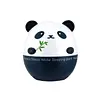What's inside
What's inside
 Key Ingredients
Key Ingredients

 Benefits
Benefits

 Concerns
Concerns

 Ingredients Side-by-side
Ingredients Side-by-side

Water
Skin ConditioningEthyl Hexanediol
SolventBenzyl Alcohol
PerfumingPrunus Persica Fruit Extract
AbrasiveBeeswax
Emulsion StabilisingCaprylyl Glycol
EmollientButylphenyl Methylpropional
PerfumingGlycerin
HumectantHydrogenated Lecithin
EmulsifyingPolysorbate 60
EmulsifyingCeramide NP
Skin ConditioningPhenoxyethanol
PreservativeTriethanolamine
BufferingOctyldodecanol
EmollientBenzyl Salicylate
PerfumingGeraniol
PerfumingParfum
MaskingDimethicone
EmollientPelargonium Graveolens Extract
MaskingGlyceryl Stearate
EmollientParaffinum Liquidum
EmollientTulipa Gesneriana Flower Extract
Skin ConditioningOryza Sativa Bran Water
MaskingPEG-100 Stearate
Carbomer
Emulsion StabilisingButylene Glycol
HumectantLinalool
Perfuming1,2-Hexanediol
Skin ConditioningCitrus Limon Fruit Extract
MaskingLimonene
PerfumingChlorphenesin
AntimicrobialCitrus Junos Fruit Extract
Skin ConditioningDisodium EDTA
Benzyl Benzoate
AntimicrobialCetearyl Alcohol
EmollientCitral
PerfumingWater, Ethyl Hexanediol, Benzyl Alcohol, Prunus Persica Fruit Extract, Beeswax, Caprylyl Glycol, Butylphenyl Methylpropional, Glycerin, Hydrogenated Lecithin, Polysorbate 60, Ceramide NP, Phenoxyethanol, Triethanolamine, Octyldodecanol, Benzyl Salicylate, Geraniol, Parfum, Dimethicone, Pelargonium Graveolens Extract, Glyceryl Stearate, Paraffinum Liquidum, Tulipa Gesneriana Flower Extract, Oryza Sativa Bran Water, PEG-100 Stearate, Carbomer, Butylene Glycol, Linalool, 1,2-Hexanediol, Citrus Limon Fruit Extract, Limonene, Chlorphenesin, Citrus Junos Fruit Extract, Disodium EDTA, Benzyl Benzoate, Cetearyl Alcohol, Citral
Water
Skin ConditioningCyclopentasiloxane
EmollientButylene Glycol
HumectantDimethicone/Vinyl Dimethicone Crosspolymer
Skin ConditioningCyclohexasiloxane
EmollientCaprylic/Capric Triglyceride
MaskingNiacinamide
SmoothingHydroxyethyl Acrylate/Sodium Acryloyldimethyl Taurate Copolymer
Emulsion StabilisingDimethicone
EmollientBetaine
HumectantHydrogenated Polydecene
EmollientPhenoxyethanol
PreservativeAllantoin
Skin ConditioningTocopheryl Acetate
AntioxidantPolysorbate 80
EmulsifyingParfum
MaskingCarbomer
Emulsion StabilisingBambusa Vulgaris Extract
Skin ConditioningBambusa Vulgaris Sap Extract
EmollientDisodium EDTA
Lavandula Angustifolia Extract
Skin ConditioningJasminum Officinale Extract
MaskingRubus Idaeus Fruit Extract
AstringentRubus Fruticosus Fruit Extract
AstringentRosmarinus Officinalis Extract
AntimicrobialOriganum Vulgare Flower/Leaf/Stem Extract
Skin ConditioningThymus Vulgaris Flower/Leaf Extract
MaskingSteareth-20
CleansingN-Hydroxysuccinimide
Skin ConditioningChlorhexidine Digluconate
AntimicrobialPotassium Sorbate
PreservativeChrysin
Skin ConditioningPalmitoyl Oligopeptide
CleansingPalmitoyl Tetrapeptide-7
Skin ConditioningPyrus Malus Juice
Skin ConditioningWater, Cyclopentasiloxane, Butylene Glycol, Dimethicone/Vinyl Dimethicone Crosspolymer, Cyclohexasiloxane, Caprylic/Capric Triglyceride, Niacinamide, Hydroxyethyl Acrylate/Sodium Acryloyldimethyl Taurate Copolymer, Dimethicone, Betaine, Hydrogenated Polydecene, Phenoxyethanol, Allantoin, Tocopheryl Acetate, Polysorbate 80, Parfum, Carbomer, Bambusa Vulgaris Extract, Bambusa Vulgaris Sap Extract, Disodium EDTA, Lavandula Angustifolia Extract, Jasminum Officinale Extract, Rubus Idaeus Fruit Extract, Rubus Fruticosus Fruit Extract, Rosmarinus Officinalis Extract, Origanum Vulgare Flower/Leaf/Stem Extract, Thymus Vulgaris Flower/Leaf Extract, Steareth-20, N-Hydroxysuccinimide, Chlorhexidine Digluconate, Potassium Sorbate, Chrysin, Palmitoyl Oligopeptide, Palmitoyl Tetrapeptide-7, Pyrus Malus Juice
Ingredients Explained
These ingredients are found in both products.
Ingredients higher up in an ingredient list are typically present in a larger amount.
Butylene Glycol (or BG) is used within cosmetic products for a few different reasons:
Overall, Butylene Glycol is a safe and well-rounded ingredient that works well with other ingredients.
Though this ingredient works well with most skin types, some people with sensitive skin may experience a reaction such as allergic rashes, closed comedones, or itchiness.
Learn more about Butylene GlycolCarbomer is a polymer of acrylic acid. Its main role is to create a gel consistency.
A high amount of carbomer can cause pilling or balling up of products. Don't worry, most products contain 1% or less of carbomer.
Dimethicone is a type of synthetic silicone created from natural materials such as quartz.
What it does:
Dimethicone comes in different viscosities:
Depending on the viscosity, dimethicone has different properties.
Ingredients lists don't always show which type is used, so we recommend reaching out to the brand if you have questions about the viscosity.
This ingredient is unlikely to cause irritation because it does not get absorbed into skin. However, people with silicone allergies should be careful about using this ingredient.
Note: Dimethicone may contribute to pilling. This is because it is not oil or water soluble, so pilling may occur when layered with products. When mixed with heavy oils in a formula, the outcome is also quite greasy.
Learn more about DimethiconeDisodium EDTA plays a role in making products more stable by aiding other preservatives.
It is a chelating agent, meaning it neutralizes metal ions that may be found in a product.
Disodium EDTA is a salt of edetic acid and is found to be safe in cosmetic ingredients.
Learn more about Disodium EDTAParfum is a catch-all term for an ingredient or more that is used to give a scent to products.
Also called "fragrance", this ingredient can be a blend of hundreds of chemicals or plant oils. This means every product with "fragrance" or "parfum" in the ingredients list is a different mixture.
For instance, Habanolide is a proprietary trade name for a specific aroma chemical. When used as a fragrance ingredient in cosmetics, most aroma chemicals fall under the broad labeling category of “FRAGRANCE” or “PARFUM” according to EU and US regulations.
The term 'parfum' or 'fragrance' is not regulated in many countries. In many cases, it is up to the brand to define this term.
For instance, many brands choose to label themselves as "fragrance-free" because they are not using synthetic fragrances. However, their products may still contain ingredients such as essential oils that are considered a fragrance by INCI standards.
One example is Calendula flower extract. Calendula is an essential oil that still imparts a scent or 'fragrance'.
Depending on the blend, the ingredients in the mixture can cause allergies and sensitivities on the skin. Some ingredients that are known EU allergens include linalool and citronellol.
Parfum can also be used to mask or cover an unpleasant scent.
The bottom line is: not all fragrances/parfum/ingredients are created equally. If you are worried about fragrances, we recommend taking a closer look at an ingredient. And of course, we always recommend speaking with a professional.
Learn more about ParfumPhenoxyethanol is a preservative that has germicide, antimicrobial, and aromatic properties. Studies show that phenoxyethanol can prevent microbial growth. By itself, it has a scent that is similar to that of a rose.
It's often used in formulations along with Caprylyl Glycol to preserve the shelf life of products.
Water. It's the most common cosmetic ingredient of all. You'll usually see it at the top of ingredient lists, meaning that it makes up the largest part of the product.
So why is it so popular? Water most often acts as a solvent - this means that it helps dissolve other ingredients into the formulation.
You'll also recognize water as that liquid we all need to stay alive. If you see this, drink a glass of water. Stay hydrated!
Learn more about Water